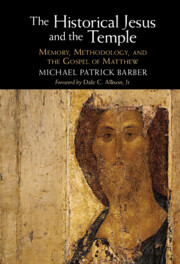Book contents
- The Historical Jesus and the Temple: Memory, Methodology, and the Gospel of Matthew
- The Historical Jesus and the Temple
- Copyright page
- Dedication
- Contents
- Foreword
- 1 Introduction
- 2 The Demise of “Authenticity” and the Challenge of Methodology
- 3 Jesus and the Jerusalem Temple
- 4 Jesus and the Destruction of the Temple
- 5 Jesus, David, and the Temple
- 6 The Son of David and the Temple-Community
- 7 Jesus, Sacrifice, and Priesthood
- Concluding Thoughts
- Appendix: Matthew within Jewish Partings
- Acknowledgments
- Bibliography
- Index of Primary Sources
- Index
1 - Introduction
Published online by Cambridge University Press: 27 April 2023
- The Historical Jesus and the Temple: Memory, Methodology, and the Gospel of Matthew
- The Historical Jesus and the Temple
- Copyright page
- Dedication
- Contents
- Foreword
- 1 Introduction
- 2 The Demise of “Authenticity” and the Challenge of Methodology
- 3 Jesus and the Jerusalem Temple
- 4 Jesus and the Destruction of the Temple
- 5 Jesus, David, and the Temple
- 6 The Son of David and the Temple-Community
- 7 Jesus, Sacrifice, and Priesthood
- Concluding Thoughts
- Appendix: Matthew within Jewish Partings
- Acknowledgments
- Bibliography
- Index of Primary Sources
- Index
Summary
The first chapter offers an introductory discussion of the major developments in scholarship that serve as points of departure for this study: (1) the problem of anti-temple biases in scholarship, which are rooted in latent antisemitic tendencies inherited by modern biblical scholarship; (2) recent developments in understanding the early Jewish character of the Jesus movement, which challenge previous assumptions about the so-called Parting of the Ways with special emphasis on recent discussions of Matthews social location (Matthew within Judaism); (3) growing concerns about historical methodology and the issue of authenticity in Jesus research. In addition, the introduction highlights the work of scholars (e.g., Matthew Thiessen, David Sim, Ulrich Luz, Donald Senior, W.D. Davies and Dale C. Allison, Jr.) who have made the case that in certain instances Matthew appears to present us with more historically plausible accounts of traditions also narrated by Mark, such as Jesuss teaching about hand washing (cf. Matt 15:1–20; cf. Mark 7:1–23), his activity in gentile regions (cf. Matt 15:21–22; cf. Mark 7:24), and the mocking of the Roman soldiers (Matt 27:28; cf. Mark 15:17).
Keywords
- Type
- Chapter
- Information
- The Historical Jesus and the TempleMemory, Methodology, and the Gospel of Matthew, pp. 1 - 19Publisher: Cambridge University PressPrint publication year: 2023



